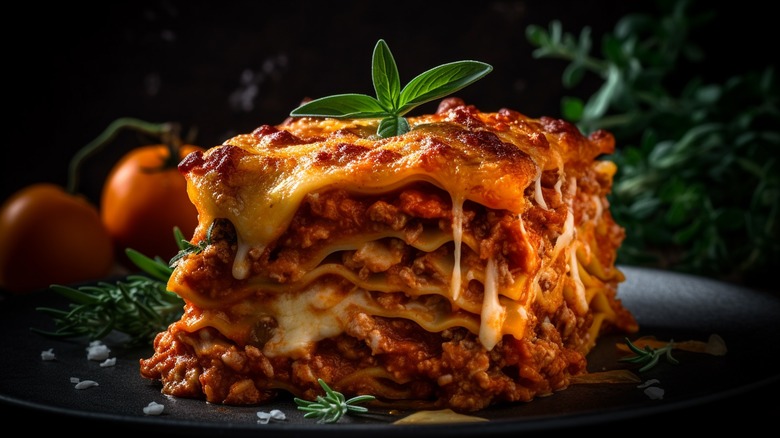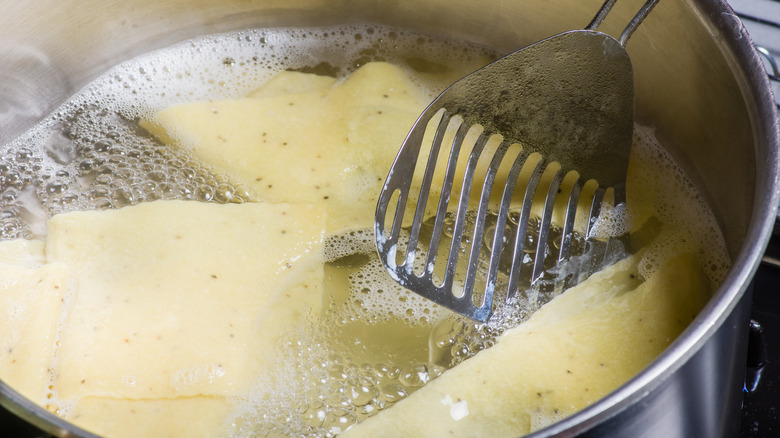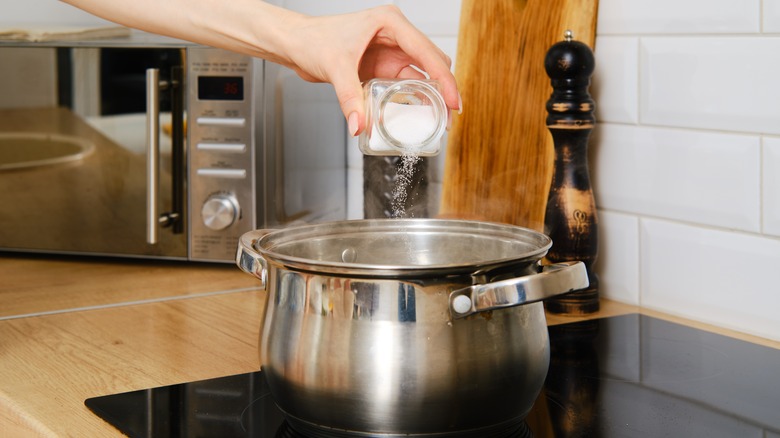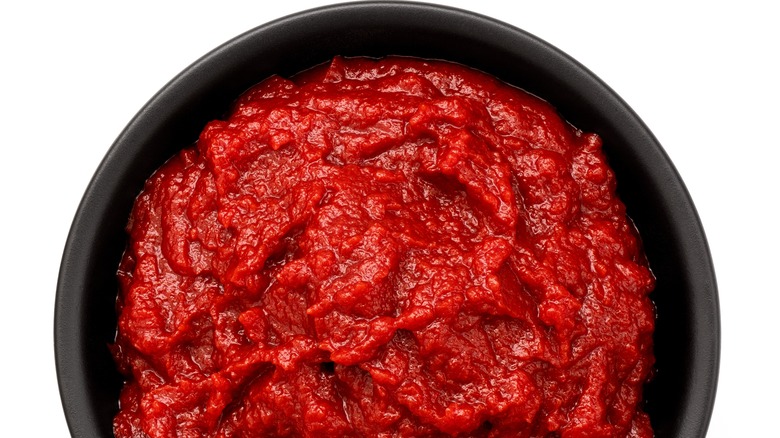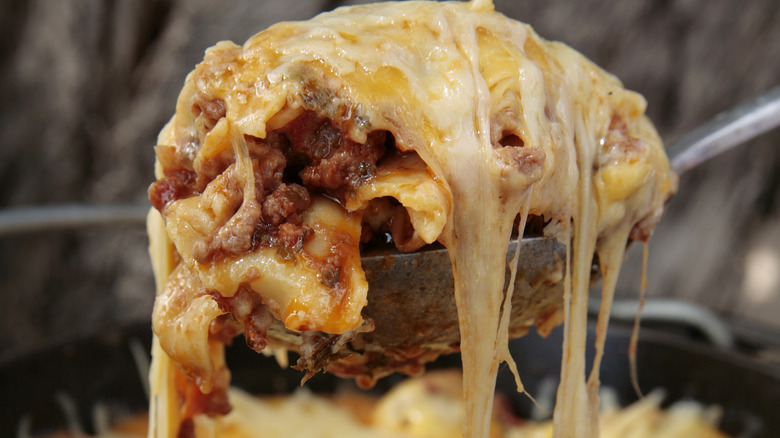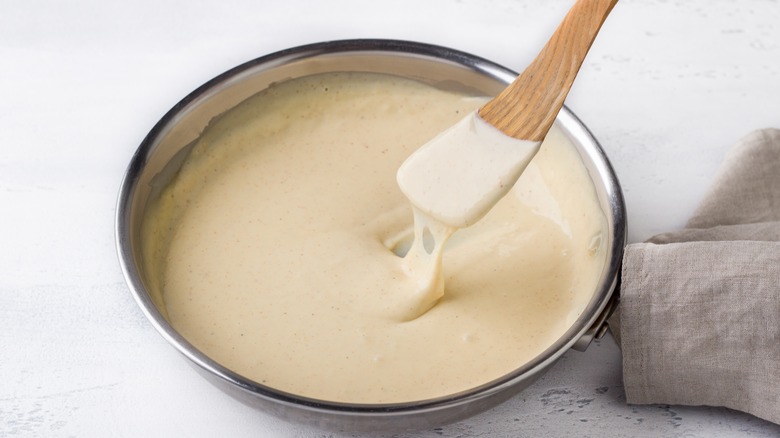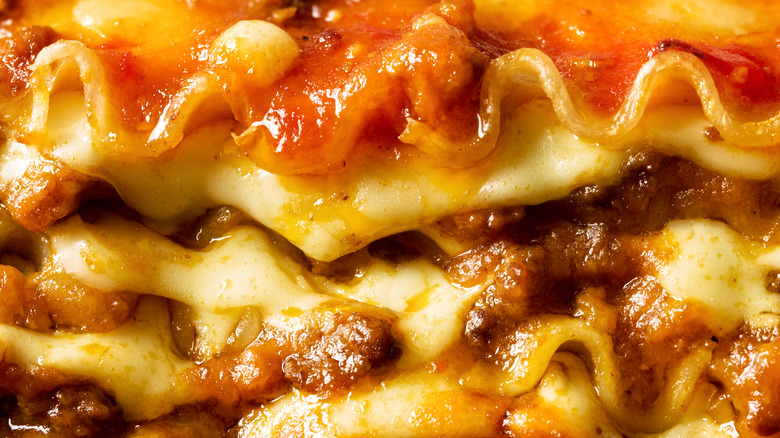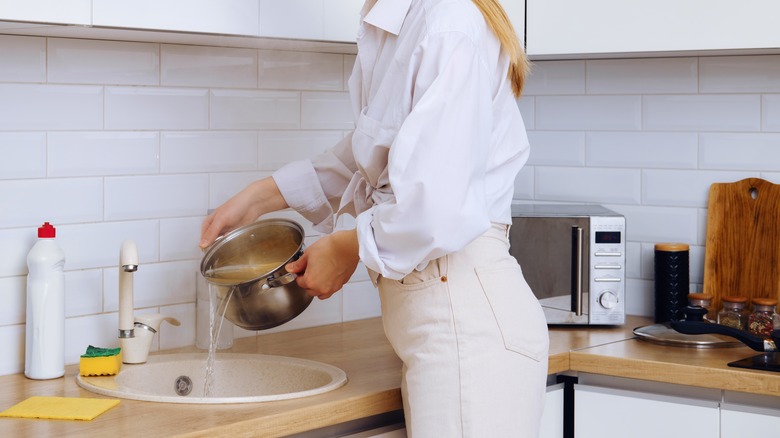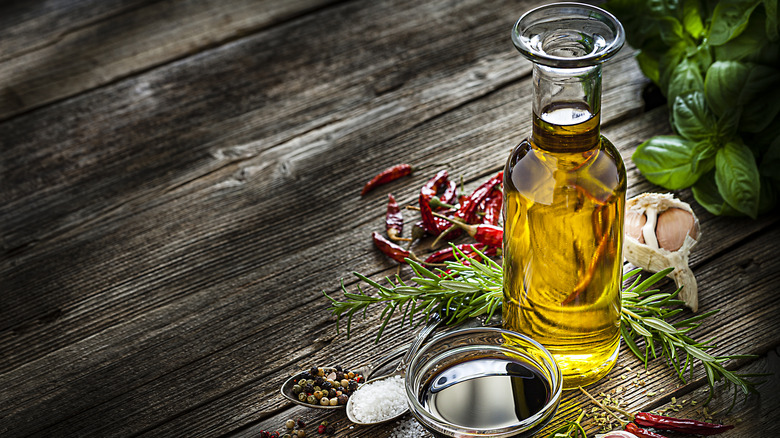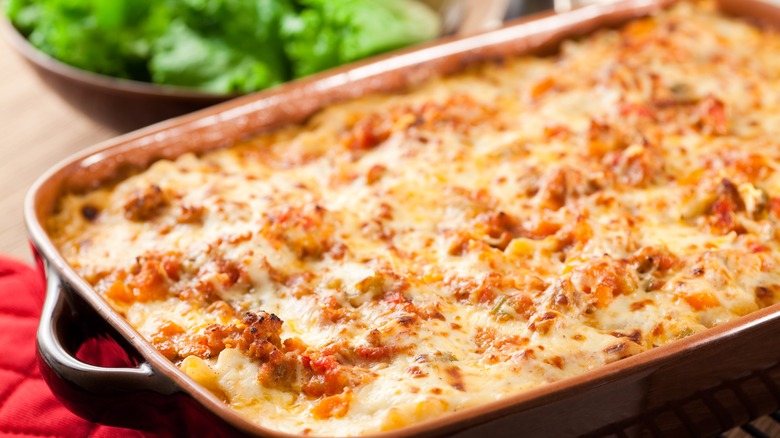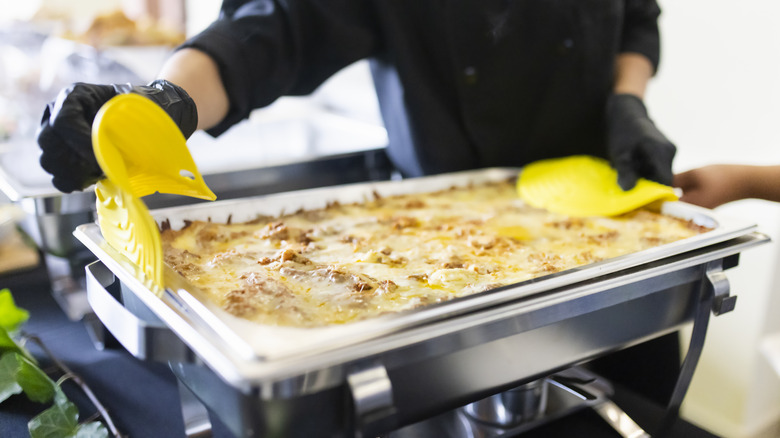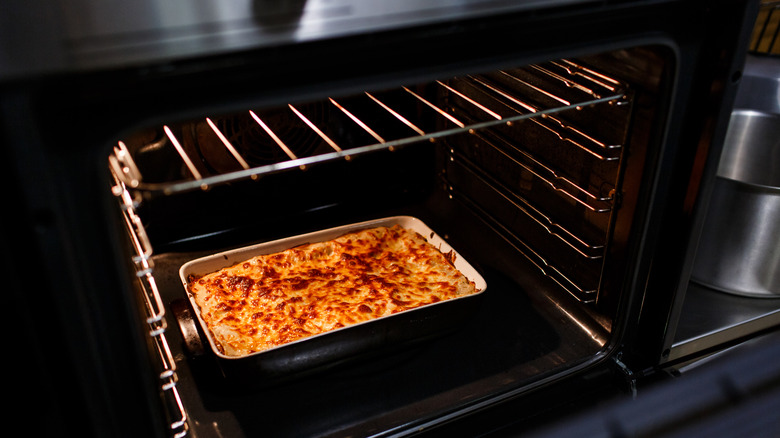This Chef Says These Are The Mistakes Everyone Makes When Cooking Lasagna
"I never met a lasagna I didn't like," said Garfield, that chubby cartoon cat created by Jim Davis. Garfield's sentiment is true of most of us, yet you probably agree that some lasagna is better than others. What makes that creamy, comforting lasagna you're served with a glass of Italian red in that unpretentious restaurant better than the lasagna you labor over at home? Is it something you're leaving out? Something you're putting in?
Both, according to Pat DiCicco, whose family's restaurant currently has 19 Central California locations, 12 of them in Fresno. DiCicco's grandparents founded the first DiCicco's in 1956, and Pat, who grew up in those restaurants, now works in food sales. When his family started the first restaurant, they baked their own bread every morning, its scent whetting the appetites of everyone within smelling distance of the place. Combining their Italian love for food with the preferences of their American customers, they served 23 to 35 giant restaurant-size pans of lasagna a week and continue to be legendary in the restaurant community of California's San Joaquin Valley today.
Making a great lasagna takes time and experience, he says. Now, DiCicco shares his tips for improving your lasagna by examining what you might be doing wrong and bringing your already good lasagna up to chef quality. "I like putting a smile on people's faces," DiCicco says. And a good lasagna can do just that.
Overcooking the noodles
You're so excited to get those noodles ready for your sauce and all the steps that follow that you boil them. And boil them. And boil them. Is this oversight going to ruin your dish? No. The lasagna will still taste fine, but it won't be as perfect as it could be. It'll lack the subtlety of lasagna prepared by skilled Italian chefs. Noodles are tricky. Undercook them, and you'll have an unappetizing texture. Overcook them, and you'll have mush. Neither is appealing, and most home chefs overcook their noodles, Pat DiCicco says. They also overstir them.
"When they're cooking them, they're stirring them too much, and then they break, and you have to kind of piecemeal them," he says. "You have to use a wooden spoon. If [the recipe] tells you to cook it for 11 minutes, cook it for 10 minutes." Your goal is to cook the pasta to al dente, or firm to the bite. The reason, according to DiCicco, is "residual cooking." Those noodles are going to continue to cook once they're out of the water, and they're going to cook again once your lasagna is in the oven.
To stay on top of this, use a kitchen timer. Sure, you can probably keep your eye on the pot of boiling noodles, but why leave it to chance? If you don't have a timer, use your cell phone.
Oversalting the noodles
Noodles are bland, right? You always add salt to the boiling water. How else are you going to keep them from making your lasagna boring? Then, you taste them and maybe add a little more salt because you want to be sure your lasagna has plenty of flavor. That's a major mistake most people make, says Pat DiCicco. "I don't put salt in the water. It's in the cheese, in the sauce, in the meat," he says.
If your noodles are too salty, you're on your way to an overly salty lasagna. While it's possible to rescue oversalted sauces by adding a slice of raw potato, you won't need to go to that trouble if you start by reducing or omitting the salt at the very beginning by boiling your lasagna noodles in unsalted water. Also, make sure the pan you use is large enough. The lasagna noodles need to be able to move around and stretch out so that they cook uniformly. You'll have better results with a pan that's too big than a smaller one that crowds your noodles. Don't worry, at this stage, about salt. You'll have plenty of opportunities to adjust your seasonings later.
Making the sauce too thick
Most of us want to pile it on when making comfort food like lasagna. The more, the better, right? Not when it comes to making the perfect sauce. Your goal is to create a nuanced dish that blends various flavors and textures, and a heavy sauce is not going to accomplish that. "Here's the trick," Pat DiCicco says. "With the sauce you use to make your lasagna, you want it on the thinner side. You want it thinner so you can spread it evenly. If the sauce is too thick, how are you going to spread it?"
He prefers making a basic tomato sauce, and once you make your own, you'll never go back to canned. Simmer onion, garlic, tomatoes, oregano, or basil together with a little salt and pepper until it's the flavor and texture you prefer. Then refrigerate or freeze it until you need it, and if you're using it in lasagna, make sure it's not too thick. Some people use broth to thin their sauce, but DiCicco says he uses water, and once the sauce reaches the right consistency, he spreads a thin layer of sauce on the bottom of the dish. Broth has a downside, he says. It doesn't add that much to the flavor. In fact, the salty taste added to the salt in your other ingredients may negatively affect the taste of your lasagna. So, keep it thin, says the chef, and the layering will be easy.
Using the wrong cheese
You can't go wrong with cheese. Some people pile on the mozzarella. Others swear by cottage cheese as the secret weapon for lasagna instead of ricotta. However, the best lasagna is made with the very best cheese. Pat DiCicco likes to add creamier cheeses like fontina or Asiago to the mozzarella, but suggests that most people use too much cheese. "Lasagna is supposed to melt in your mouth," he says. That's difficult to do when it's buried under a mountain of cheese. He has a tip for dealing with hard cheeses, too: Pick up small pieces of Parmesan or pecorino on sale. "It's the cheapest way to buy cheese, and they stay nice in the freezer," he says. An expensive cheese, even in a small amount, will elevate your lasagna. "The better the cheese, the better the lasagna," DiCicco notes.
Grating cheese is always a risk, especially when you're distracted. How many times have you bloodied your knuckles because you were in a hurry or the cheese bounced off the grater? The solution? Put the cheese in a small personal blender the way Italian chef DiCicco does. "It's the best place to grate coffee beans or cheese," he says. In moments, you'll have cheese that smells and tastes freshly grated. Serve a little extra at the table, along with a bowl of warm sauce, and you'll have a dish that is worthy of the time you put into it.
Forgetting béchamel sauce
You don't have to use béchamel sauce every time you make lasagna, but you should be aware of why it's an important option. First of all, it's delicious. One of the five mother sauces (along with hollandaise, velouté, Espagnole, and tomato), it is made from a simple roux of flour, butter, and milk and seasoned with cloves, nutmeg, and/or black pepper. According to Pat DiCicco, it's one lasagna ingredient many Italian cooks use. He points out that depending on the region, Italians use either ricotta or béchamel as the creamy layer of the dish. Some also grate an egg into the lasagna, and per DiCicco, the grated boiled egg melts like cheese.
"I make it both ways, either with ricotta or with béchamel," he says. "But I prefer to make it with béchamel."
Béchamel has another benefit as well — digestion. "Just a hint of béchamel sauce gives it a nice texture," DiCicco says. "And it won't give you heartburn." According to him, there are two reasons people get heartburn from tomato sauce. "One, the tomatoes they used weren't ripe enough, or two, they overcooked it." A hint of béchamel sauce added to the red sauce will solve that problem, he says, as will a hint of sugar or heavy cream. Whether to use béchamel or ricotta is a matter of personal taste. Just be aware of your options.
Making too many layers
Once you've invested the time and energy into making lasagna, you might be tempted to keep building it layer upon layer. You can't have too much of a good thing, can you? According to Pat DiCicco, you can. He says you should make two or three layers; no more than three.
"If you put a layer of sauce on the very bottom, it'll help keep it more moist," DiCicco says. Then, build your layers with meat, if you're using it, ricotta cheese or béchamel, and then more cheese on the top. These are substantial layers, and you don't need that many of them. "You can use fresh mozzarella or dried mozzarella," DiCicco says. "Hard cheeses, you always grate. Soft cheeses, you shred. You can also slice them and layer them like that if you have a slicer. Or you can buy the sliced mozzarella and do it like that." He suggests using a young Parmesan when layering with the mozzarella cheese, and an aged, more expensive Parmesan on top.
And go easy on the vegetables. Some parts of Italy will make a ragù sauce with a combination of celery, onion, and carrots, known as sofrito in Italy and a mirepoix in France. "You've got to be careful when you use that," DiCicco says. "If you put in too many carrots or celery, it will destroy your lasagna. Use celery lightly as a condiment. You don't want your sauce to taste like a stalk of celery."
Forgetting the water bath
We've all done this. We boil the lasagna noodles while we're putting together the ingredients for the sauce, and then we run some cold water over the freshly cooked noodles and call it good. But it isn't good. You've barely started building the lasagna when your noodles start tearing. They stick together and make a mess, and pretty soon that beautiful lasagna begins to look like a noodle bowl gone wrong.
You will never again have to worry about broken or sticky noodles if you place them in a cold water bath once you boil and drain them. Take your time with all of the other ingredients you'll be adding to your lasagna, and you don't give the noodles a second thought until you're ready for them. The cold water not only stops the cooking better than a quick rinse will, but it will keep the noodles from sticking together and make your assembly much easier. What happens if you get distracted or if your plans change? According to Pat DiCicco, there's a secret ingredient you can add: olive oil.
If you're not going to use the lasagna noodles immediately, you can toss them with olive oil, put them in the fridge, and they will keep for 24 hours. With the water bath — and olive oil in a pinch — you'll be confident that your noodles will be a worthy showcase for your very best filling.
Using too many spices
When you're making lasagna, you might be tempted to layer on the seasonings. This is an Italian dish, after all; it requires Italian seasonings. There may be a time when you want to veer from the traditional and experiment with unique ingredients you could be using in your lasagna, ranging from sun-dried tomatoes to pesto. If you want a lasagna that looks and tastes as if it came from an Italian chef, however, keep it simple, Pat DiCicco says. "Five, maybe six ingredients. That's it. Most people over-season their sauce. They think more is better. If you put more than five ingredients in it, you're probably going overboard." He emphasizes the importance of what he calls "a clean bite." When you bite into that perfectly assembled lasagna, you don't want your tastebuds to encounter a barrage of conflicting flavors.
The same is true of the meat you use. Perhaps you're using the traditional ground beef or sausage; maybe sausage mixed with ground turkey if you want a lighter sauce. Whatever you choose, make sure it cools off to room temperature before you start adding extra seasonings. Once you're finishing the sauce, it is time to decide if you'd like to add a little olive oil or fresh basil. You can even add a little bit of butter to make it more creamy.
Not letting the lasagna rest
Lasagna is not ramen. It's not heat-and-eat. The process is more a matter of anticipation than instant gratification, and it cannot be rushed. According to Pat DiCicco, after building the lasagna, "It's best to let it sit and cook it the next day." So, you've gone to all this trouble, combined all these ingredients, and you can't even put your lasagna in the oven until tomorrow? It makes a difference, DiCicco says. If you want to eat the lasagna tomorrow, make it today. By waiting overnight, you'll allow the flavors to blend and the lasagna to firm up.
"I put a layer of film and then put aluminum foil on top of it," DiCicco says. He suggests making more than one lasagna at a time. That way, you'll always have one ready to go. "You've made all this mess," he says. "You might as well make two or three lasagnas." If you do, you can hurry to process because you will have already done most of the time-consuming tasks.
Not using a bain marie
When you finish your lasagna, think like a chef, and you'll end up with a chef-worthy creation. That means don't just bake the lasagna. A bain marie is ideal for keeping a uniform temperature around the lasagna as it cooks, Pat DiCicco says. Although it's best not to simply bake lasagna, many people do. "They just put it in the oven because it's all they were taught," DiCicco says.
You may not have a commercial steam table in your kitchen, but you can still get the same effect without spending a dime. DiCicco suggests putting the lasagna on a bigger pan or cookie sheet with high sides. Add hot water around the lasagna pan so that the lasagna will bake in its own dish while that dish sits in the barely simmering water bath. The concept is the same as when you use a double boiler to melt chocolate or make hollandaise sauce. When you taste the difference, this is one step you will not skip.
Cooking it too long
You've boiled the noodles and cooled them in a water bath as you built your lasagna. You've let it rest, and now you're ready to put the lasagna dish in the oven, preferably in a larger pan of gently simmering water. You're home free — almost. Now, you want to set your timer so that you don't overcook it. A moist lasagna is a tender lasagna, and you won't get a tender lasagna if you overcook it. Instead, you'll have something like tough noodles and rubbery cheese. Your timer (or cell phone) is your secret ingredient when it comes to this final step.
"Cook it covered, 30-40 minutes," Pat DiCicco says. "After you cook it, let it set for at least 30 minutes. If you don't, all those cheeses are going to settle, and you've just defeated your purpose of making a lasagna." He says it's better to undercook than overcook your lasagna. Test it with a toothpick just the way you'd test a cake.

